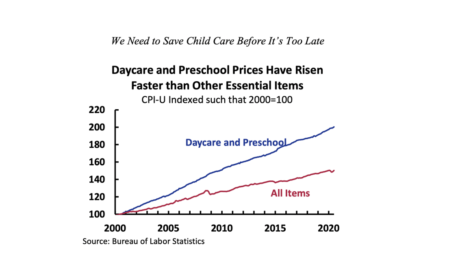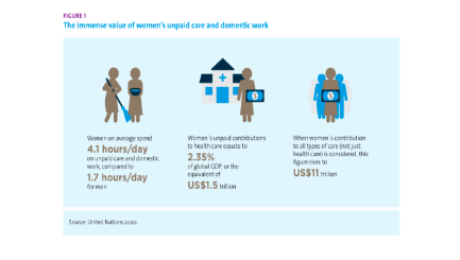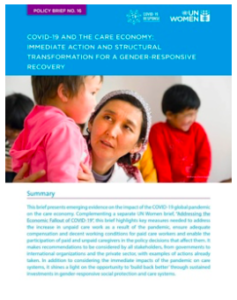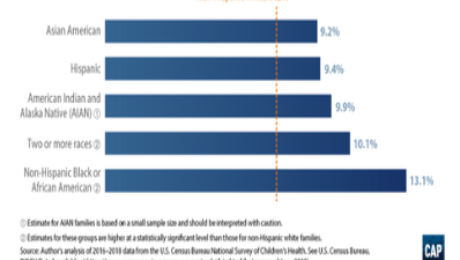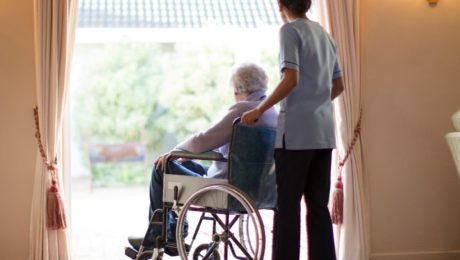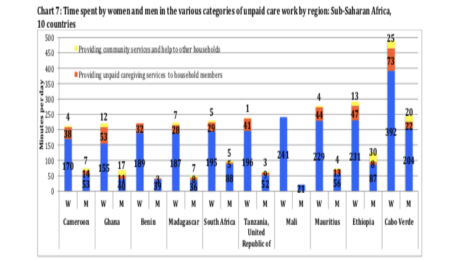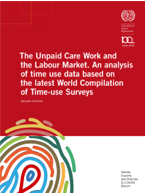U.S. Needs to Save Child Care Before It’s Too Late
The childcare system in the US was already in a critical state of inadequacy, and the COVID-19 pandemic has only made this worse. A recent report released by the U.S. Congress Joint Economic Committee (JEC) – “We Need to Save Child Care Before It’s Too late” – explores the U.S. childcare crisis in detail, outlining the shortages in child care and the consequent economics effects of those shortages.
According to the report, as of August 2020, roughly 214,000 U.S. childcare workers were out of a job and 4 out of 5 childcare providers expected to close permanently if no public assistance is provided. This is of course having a trickle-down effect on the working parents that rely on this childcare, and 13% of parents reported having to reduce their working hours.
This issue is further compounded in the many areas throughout the country considered to be “childcare deserts” where the supply of childcare falls well below the demand and for many families is not accessible due to cost constraints. Although there are assistance programs available for those in need, such as the Head Start program, many of those that qualify still do not receive assistance due to severe lack of funding. In over half of states, childcare and early childhood education exceeds the cost of college tuition, and bearing this burden is extremely difficult for lower income families.
Middle income families that do not qualify at all for government funded programs are under even more strain with the financial obligations of childcare. Infant care is in particular incredibly expensive, and a median income family home could spend anywhere from 23% to 77% of their income on the care of their infant, depending on the state. For single mothers in the median income range, this could be from 29% to 94%.
Childcare costs in the U.S. are exponentially higher than its OECD counterparts. The U.S. spends less that half the amount of its GDP on childcare in comparison to the average of other OECD nations. In fact, the U.S. spends 3 to 6 times less than France, New Zealand, and all the Nordic countries. Where in many OECD nations, childcare is free or very inexpensive, making it widely accessible, in the US, the accessibility and quality of childcare for working parents is contingents upon their economic status. A lack of accessible and affordable childcare leads to lost earnings for parents, an estimated $20 – $35 billion in total, according to the Economic Policy Institute. This in turn translates into a loss of roughly $4.2 billion dollars in federal and state tax revenue per year. The cost of childcare is skyrocketing past the rate of inflations as well, between the years 2000 and 2020, day care and preschool costs rose double that of inflation.
Extensive research has shown that accessible and affordable childcare has strong positive economic benefits and contributes to the well-being of children and parents. Without the benefit of accessible and affordable childcare, many parents, mostly women, experience reduced earnings for the duration of their careers. This also contributes tremendously to the gender wage gap. Furthermore, according to a 2015 Council of Economic Advisors report, every dollar spent on childcare and early education carries the potential to yield eight dollars in societal benefit.
Childcare workers also struggle due to low wages, poor benefits, and precarious working conditions. In 2017, an average childcare employer kept 13 workers on payroll, each of whom earned just $20,886 on average in annual compensation. In 2019, the median hourly wage of U.S. childcare workers was $11.65, a near-poverty wage. Nonetheless, employee’s compensation is the highest cost for these establishments, as they must maintain a low ratio of children to caretaker, which varies from state to state. Cost of rent is another major expense for childcare providers, but reducing the size of the facility, and therefore the rent costs, is not a viable option as crowding and lack of outdoor space has been shown to increase the risk of infections and injury within the centers.
There is still a great amount of work to be done in the U.S. The CARES Act passed in March of 2020 provided $3.5 billion of funding to states in childcare subsidies for low income families. Additionally, the inclusion of the Paycheck Protection Program (PPP) provided $2.3 billion to childcare providers across the country, enabling 460,000 childcare workers to remain employed. Although these measures were helpful, much more assistance is still needed. For the most part, smaller childcare centers and home-based programs were not able to access these PPP funds at all, with only 29% of them receiving these funds. The vast majority of childcare operations across the board, many of which single-person operations, were also not able to access these PPP funds at all. The HEROES Act, passed in the House of Representatives in May, would provide another $7 billion in relief for childcare centers and $850 to fund child and family care for essential workers. However, this legislation has stalled in the Senate.
This pandemic has dealt a devastating blow to an already inadequate childcare system in the U.S. Without desperately needed assistance, the U.S. faces the potential of losing 80% of its childcare capacity. This will in turn deprive working parents of the critical services and infrastructure needed for the economy to recover. Read the complete report “We Need to Save Child Care Before It’s Too Late.”
This blog was authored by Jenn Brown, CWE-GAM Communications Assistant
- Published in Child Care, Policy, U.S.
Digital Forum on Reopening Long Island and Building a Fair Economy:Care Work in the COVID Crisis
Earlier this month, the Hofstra Labor Studies and the Center for the Study of Labor and Democracy in collaboration with Long Island Jobs with Justice and A.L.L.O.W. (Advancing Local Leadership Opportunities for Women) conducted a virtual forum addressing care work in the context of COVID-19. This discussion emphasized the financial and mental health challenges associated with all types of care work during this pandemic, and the immense need to address and resolve these issues in order to assist with a fair and sustainable economic recovery. Although the discussion is focused primarily on Long Island and New York, the problems indicated are applicable to care work throughout the U.S.
There is anecdotal evidence to suggest that the unemployment or the stress of juggling work and home life as a result of the crisis has hit women much harder than men. This discussion utilized academia as an example of this, drawing upon data indicating that academic journal submissions have greatly increased among men since the beginning of the pandemic, but sharply decreased among women. For those working in academia, publishing work is crucial to professional advancement.
The pandemic has also shed a harsh light on the fragility of the overall childcare system in the U.S. Many families lacked adequate childcare even before the pandemic, forcing them to rely on unpaid care work. These existing issues paired with the recent closures of childcare facilities has exacerbated the problem.
Although the CARES Act did include childcare support, New York receiving $164 million going toward the childcare industry to provide protective equipment and cleaning supplies, the panel argues that while helpful those measures still did not provide adequate relief. The HEROES Act could potentially provide further relief for the care industry, but participants of this forum are less than optimistic about it providing the level relief needed.
The International Labor Organization estimates that three-quarters of unpaid care worldwide is provided by women. In the U.S. women provide 37% more unpaid care work than men on a daily basis. Among care providers in the U.S., Hispanic women do the majority of unpaid care and account for the biggest gap among men and women. Beyond traditional gender roles, this is largely tied to economics; oftentimes men have opportunities to make more money. But generally speaking, even when both parents work full time, women are still taking on more unpaid work even if they are earning more money than the male figure within the household.
There is also a societal tendency which expects care workers to be exceptionally giving. This is highlighted in the fact that even within paid care work positions, there is a fair amount of unpaid work being performed. For example, staying with an elderly person at their doctor’s appointment a couple of hours after the official workday has ended. This is a constant strain within the care industry, and COVID-19 has increased the pressure on this component of unpaid work within the paid care industry.
Additionally, the many racial and ethnic disparities within care work serve as a microcosm of larger racial inequities prevalent in society. For example, in New York, 80% of care workers are women, and a large majority of them are women of color. Furthermore, care workers in New York typically make minimum wage yet are still known to go above and beyond in their roles to ensure the best care is provided, regardless of whether or not it is part of their job description. This existing issue has been pushed to a new level due to COVID-19; now many of our care workers are putting their lives on the line.
Part of the reason that low wages are prevalent within the care sector is the historical association that care work is a “women’s job,” coming naturally and requiring little skillset. This sentiment in the U.S. is compounded by care work being viewed as the responsibility of the individual. The decision to have a family is viewed as a personal choice, therefore the basic needs of childcare are the sole responsibility of the parents, not something to be addressed via larger social safety nets.
New York is facing a particularly troubling dilemma within its care work industry. Despite the fact that a large majority of the workforce is comprised of immigrants, the guidelines that have been released outlining protection measures from COVID-19 are only available in English. This is concerning given that some workers may not yet possess the English language proficiency necessary to fully comprehend these guidelines.
In order to address these strains within the care work industry, political will and national policy are needed. The U.S. Department of Defense provides an exemplary model that could be emulated on a national scale. This government sector presently has one of the best childcare systems available in the U.S., operating on a sliding scale making it accessible to all those within the department that need it. This allows these federal employees to perform their duties with the comfort of this social safety net.
Furthermore, at the local level, immediate state, and county-level funding for care work can have a significant impact on the accessibility needed during this stressful time. Without swift action on the policy level, the issues discussed will continue and have detrimental effects on not only families, but economic recovery as well.
This blog was authored by Jenn Brown, CWE-GAM Communications Assistant
- Published in COVID 19, Expert Dialogues & Forums, Policy, U.S.
COVID-19 AND THE CARE ECONOMY: UN Women calls for immediate action and structural transformation for a gender-responsive recovery
A recent brief from UN Women presents emerging evidence on the impact of the COVID-19 global pandemic on the care economy.
Evidence suggests that the rising demand for care in the context of the COVID-19 crisis and response will likely deepen already existing inequalities in the gender division of labor, placing a disproportionate burden on women and girls. Not only are women over-represented among paid health care workers, girls and women also shoulders the bulk of unpaid care and domestic work that sustains families and communities on a day-to-day basis.
School closures and household isolation across the globe are moving the work of caring for children from the paid economy—schools, day-care centers, and babysitters—to the unpaid economy. So far, 1.27 billion students (72.4 percent) across 177 countries have been affected by school closures (UNESCO). The lack of childcare support is particularly problematic for essential workers, including those in the health sector, who have care responsibilities.
This brief recommends ways to transform care systems now and for the future – both the need for immediate support and the need for sustained investment in the care economy for long term recovery and resilience.
How to Transform Care Systems – Now and for the future
(UN Women, 2020)
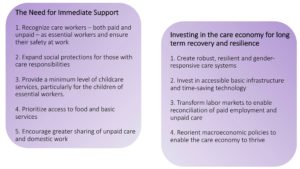
Authors/editor(s): Bobo Diallo, Seemin Qayum, and Silke Staab 2020
- Published in COVID 19, Policy Briefs & Reports, UN Women
The True Cost of Caregiving: An Aspen Institute Digital Discussion
Even in a typical year, U.S. households are estimated to experience $31.9 billion in lost wages as a result of inadequate childcare and paid leave. Roughly 1 in 5 people living in the U.S. today incur caregiving expenses, and the need for care work is experienced in nearly every household at least once. Those who are professional care workers, disproportionately women of color, are underpaid and therefore susceptible to financial insecurity. Those insecurities have been exacerbated even further amidst COVID-19 and the resulting economic downturn.
In June 2020, the Aspen Institute Business and Society Program hosted a digital discussion “Paid Leave, Livable Wage, Affordable Care: Policies that Could Avert the Next Crisis” in conjunction a policy brief “The True Cost of Caregiving” that was released in May. Within this discussion, the panel focused on the fragility of the care system and the financial stability of those providing care, both paid and unpaid. The panel not only addresses these issues but seeks to re-imagine a system in which care is treated like a public good, examines the hierarchy of human value, delves into the historical context behind care work in the U.S., the vulnerability of care workers in the current pandemic, and the inefficiency of the current care economy within the larger economic system.
A number of important questioned are addressed such as:
– How to quantify the benefits of paid leave, livable wages, and affordable care policies?
-What are feasible policy responses to COVID-19, in both the short term and long term, that can lead to better systems of caregiving in the U.S?
-What does an inclusive and equitable care system could look like?
-Who bears responsibility for building this system?
Further, this panel brings to the table the idea that care work should be invested in collectively as a nation, as opposed to being looked at as an individual burden; which puts increasing downward pressure on those who are already disadvantaged in the U.S. due to race and gender.
Policies that address these concerns could assist in not only building a more equitable system of care but have the potential to aid in averting future crises like that which the care economy finds itself in today.
- Published in Child Care, Expert Dialogues & Forums, Policy, U.S.
Inequalities in access to U.S. care services
In the U.S., states and localities are beginning to ease social distancing policies resulting from the pandemic. With many workplaces calling Americans to return to work, the nation’s care services system, what was already broken, is now in dire need of repair or replace.
According to a recent analysis by the Center for American Progress (CAP), the lack of adequate child care services in the U.S. negatively affected communities of color before the pandemic, as parents of color were more likely than their non-Hispanic white counterparts to experience child care-related job disruptions that could affect their families’ finances.
The analysis uses the National Survey of Children’s Health (NSCH) to show that before the pandemic, Black and multiracial parents experienced child care-related job disruptions—such as quitting a job, not taking a job, or greatly changing their job—due to problems with child care at nearly twice the rate of white parents.
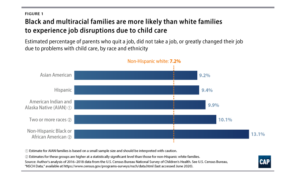
For Black workers and workers of color, decades of occupational and residential segregation has translated to less access to telework, and therefore less flexibility within their responsibilities for young children or elders. In fact, most Black workers and workers of color (especially those who are women) have had to work through the pandemic in essential frontline occupations.
The analysis shows that prior to the pandemic, adequate and affordable child care services was short in supply, particularly for Black, Latinx, and Indigenous families. In fact, more than half of Latinx and American Indian and Alaska Native (AIAN) families have experiences living in a child care desert – which is an area suffering from an inadequate supply of licensed childcare.
Using child care services as an example, the analysis shows that disparities will likely worsen in the aftermath of the pandemic. A previous CAP analysis estimated that nearly 4.5 million child care slots could disappear permanently as a result of COVID-19, effectively cutting an already inadequate child care supply in half. Recent data suggest that this impact is already being felt, with more than 336,000 child care providers—many of whom are immigrants, African American, or Hispanic—losing their jobs between March and April.
Allowing care services to flounder should not be an option; a broken and inadequate care system would slow the nation’s economic recovery and in addition to deepening existing economic and racial inequalities.
This blog was authored by Shirin Arslan, Program Manager for the Care Work and the Economy Project
- Published in Child Care, Gender Inequalities, Race Inequality
The Covid-19 Care Penalty
In the U.S., as elsewhere, essential workers have been rightly praised for their willingness to take on additional risk and stress. Their commitment to helping patients, students, and customers face-to-face went beyond the ordinary requirements of earning a paycheck. Yet some essential workers faced more serious risks of infection than others, and differences in pay among them were also significant. The abrupt creation of a new category of workers based on social need, rather than market forces, dramatized an important question: why do we often see a disjuncture between the social value of work and its private, pecuniary reward?
Feminist research addresses this question in a number of ways, emphasizing factors such as employer discrimination, monopoly or monopsony power, and intersectional differences in the relative bargaining power of distinct groups of workers. The distinctive features of care work—intrinsic motivation, emotional skills, team production, and positive spillover effects—have also received attention. Leila Gautham, Kristin Smith and I have been building on previous research on care penalties to show that essential workers in care services (health, education, and social service industries) are paid less than other essential workers (in law enforcement, support and waste services, transportation, agriculture, retail and financial industries) with comparable personal and work characteristics, a pattern with especially costly consequences for women. Low-wage workers such as health aides are especially vulnerable, but care penalties also help explain the vulnerability of doctors and nurses in ways mediated by unique institutional features of the U.S. health care system.
A paper on this research is now under review. Once this process is complete, I’ll come back with more details.
Original blog published on CARE TALK: FEMINIST AND POLITICAL ECONOMY on June 11, 2020. See here for the original posting.
Reposted with permission from Dr. Nancy Folbre from University of Massachusetts Amherst and an expert researcher for the Care Work and the Economy Project within the Rethinking Macroeconomics working group.
- Published in COVID 19, Feminist Economics
Frontline Care Workers in the U.S.
A recent report on Basic Demographic Profile of Workers in U.S. Frontline Industries by the Center for Economic and Policy Research (CEPR) looks at six broad industries, employing grocery store clerks, warehouse workers, bus drivers, and care workers – including nurses, care workers at child care and residential care facilities, as well as household and community service workers.
Based on CEPR’s analysis using the American Community Survey (2014 – 2018), over half of all essential workers in the industries examined are employed in care services. More than a third of these workers are over the age of 50; and before the pandemic, nearly a quarter were living in low-income households and about half lived with a child or a senior at home.
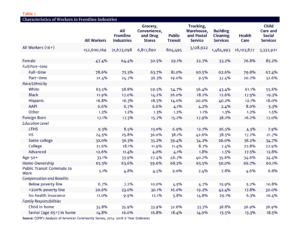
At the national level, women workers are overrepresented in frontline industries. About one-half of all workers are women, but nearly two-thirds (64.4 percent) of frontline workers are women. Women are particularly overrepresented in care-work related industries – Healthcare (76.8 percent of workers) and Child Care and Social Services (85.2 percent).
Black and Hispanic workers, as well as other people of color are also overrepresented in many frontline industries occupations. Black workers are most overrepresented in Child Care and Social Services (19.3 percent of workers). Hispanic workers are especially overrepresented in Building Cleaning Services (40.2 percent). Immigrants are also overrepresented in Building Cleaning Services and in many frontline occupations in other frontline industries.
The report calls on U.S. congress to include important protections for frontline workers in its response to COVID-19 – including comprehensive health-care insurance, paid sick and family leave, free child-care, student loan relief and other labor protections related to workers’ health, safety and immigration status.
About the report:
A Basic Demographic Profile of Workers in Frontline Industries. Hye Jin Rho, Hayley Brown, and Shawn Fremstad. Center for Economic and Policy Research. April 2020.
- Published in Child Care, COVID 19
Unpaid Work, Animated
About half of all the time devoted to work in the U.S. is devoted to unpaid work in the home. The Institute for New Economic Thinking has created an adorable animation of some comments I made in an interview with them on this topic a while back.
It’s quite a lot of fun, and basically accurate. Just don’t pay too much attention to the numbers they inserted into my discussion of two families, each with a market income of $50,000–the animation seems to imply that leisure should be assigned a monetary valuation–not something I advocate. Still, the main point comes through just fine: conventional measures provide a misleading picture of living standards.
The animation provides a great introduction to the topic for students, and you can find a more academic version of the basic argument in a short briefing paper I wrote for the Washington Center for Equitable Growth.
Original blog published on CARE TALK: FEMINIST AND POLITICAL ECONOMY on June 11, 2020. See here for the original posting.
Reposted with permission from Dr. Nancy Folbre from University of Massachusetts Amherst and an expert researcher for the Care Work and the Economy Project within the Rethinking Macroeconomics working group.
- Published in Expert Dialogues & Forums, Feminist Economics, Rethinking Macroeconomics
The Unpaid Care Work and the Labor Market. An analysis of time use data based on the latest World Compilation of Time-use Surveys
How much time do people spend on doing paid and unpaid care work? How do women and men spend their time differently on unpaid care work? Are there any differences in time use among the regions? How do socioeconomic factors influence people’s choices to do paid and unpaid care work?
Jacques Charmes addresses these questions in recent ILO report by providing a comprehensive overview of the extent, characteristics and historical trends of unpaid care work. The report is based on the analysis of the most recent time-use surveys carried out at the national level across the world, revealing the differences in time spent on unpaid care work between women and men and among people with different socioeconomic characteristics, such as geographical location, age and income groups, education level, marital status and the presence and age of children in the household. An insightful discussion of the concepts and methodological approaches underlying the analysis of time-use data is also offered.
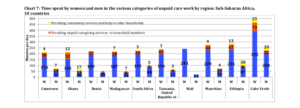
Chart 7 in the ILO Working Paper the Unpaid Care Work and the Labour Market. An analysis of time use data based on the latest World Compilation of Time-use Surveys illustrates the time spent by women and men in various categories of unpaid care work across Sub-Saharan African countries including Cameron, Ghana, Benin, Madagascar, South Africa, Tanzania, Mali, Mauritius, Ethiopia and Cabo Verde. As with the case around the world, women in Sub-Saharan African countries are providing significantly more unpaid care services in households and communities. Read the report to learn more about time-use analysis concepts and methodologies, gender variations in paid and unpaid work across the world and across various socio-economic levels:
International Labour Organization
Gender, Equality and Diversity & ILOAIDS Branch
This blog was authored by Shirin Arslan, Program Manager for the Care Work and the Economy Project
- Published in Child Care, elderly care, Policy Briefs & Reports

